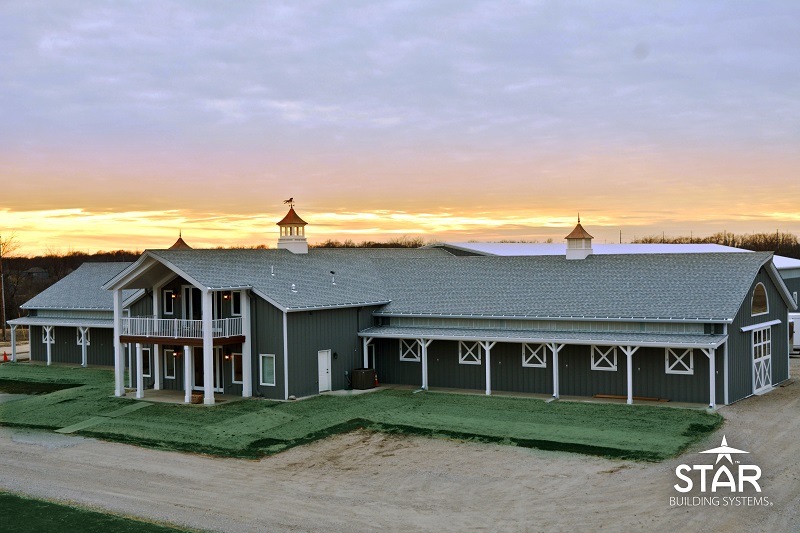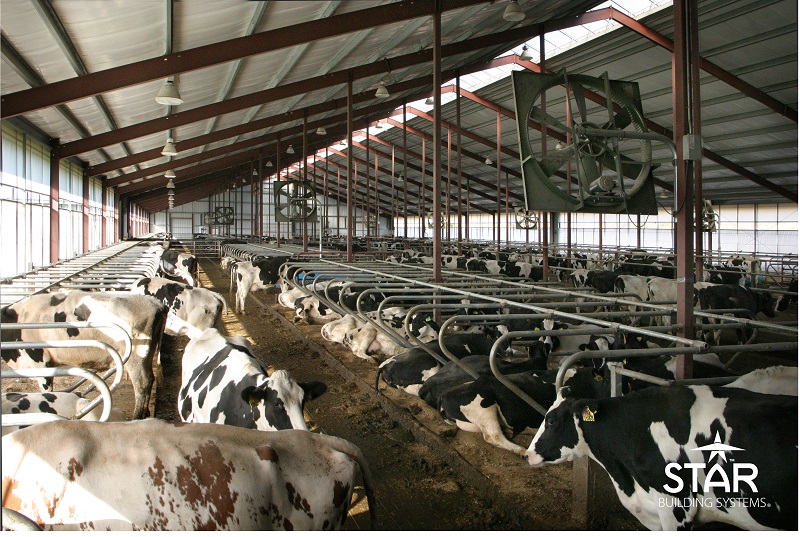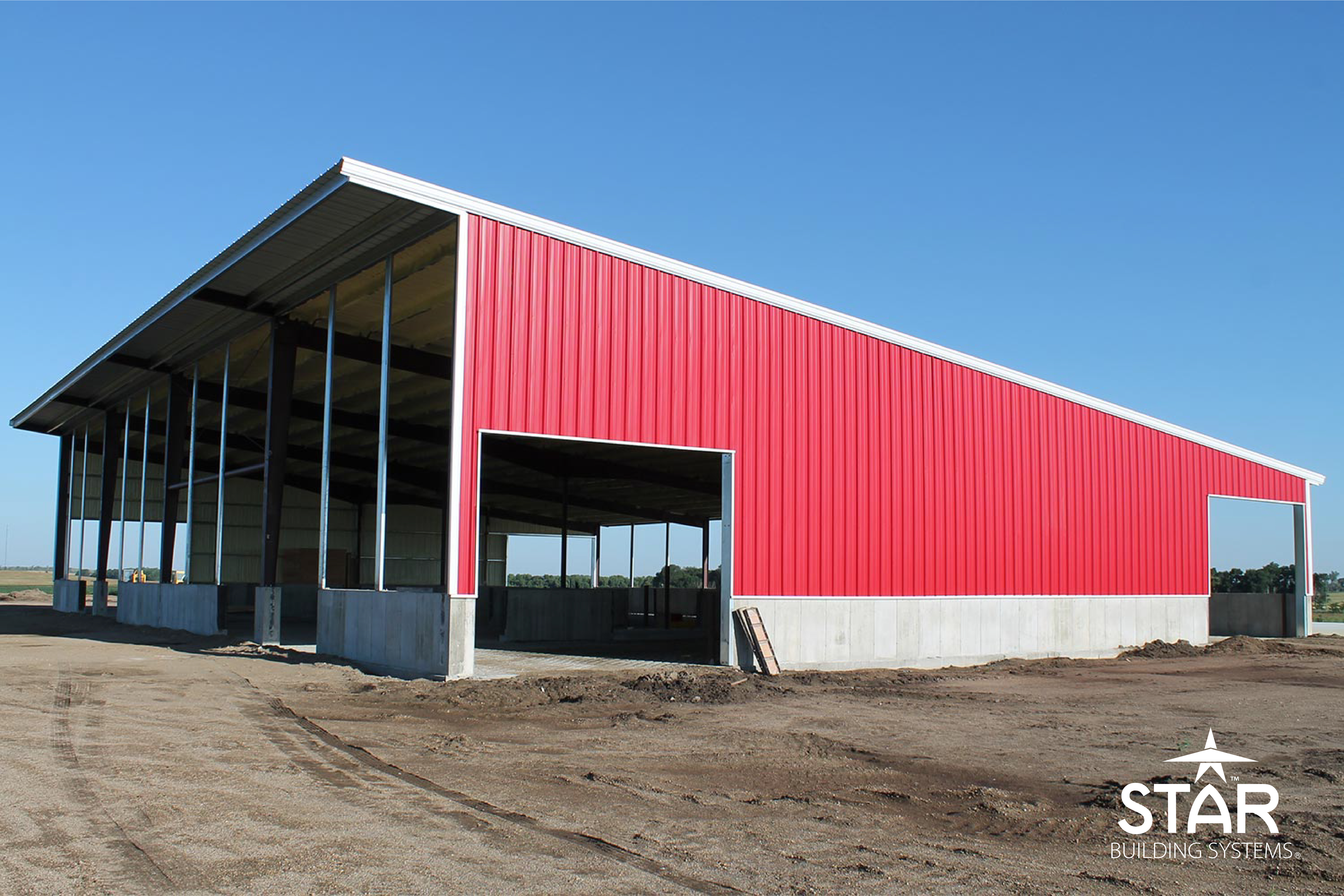Working farms and ranches need facilities that can stand up to corrosive animal waste, hot summers, harsh winters and provide proper storage for equipment, livestock, feed and more. Metal buildings provide numerous advantages to the agricultural marketplace with their many uses – and benefits. They meet typical industry standards of maximum storage space, maneuverability and protection. Star Building Systems has been providing custom-engineered metal building systems to the agriculture industry for years. Star buildings are also compatible with any conventional exterior, allowing for customized aesthetic designs that stand up to the wear and tear of their environments.
 Cobalt Stables combined horse stables and training facilities with a human residence – all under one roof. Learn more.
Cobalt Stables combined horse stables and training facilities with a human residence – all under one roof. Learn more.
Benefits to the Agricultural Industry
Durability: Your agriculture building is an investment – it needs to work now, and for decades to come. Metal buildings are sturdier than traditional buildings, withstanding harsh weather conditions such as strong winds, heavy snow, thunderstorms and extreme temperatures. They are also NOT susceptible to the same type of damage that wood buildings endure, such as termite, carpenter ant or other insect damage.
Efficiency: Steel buildings provide an enormous amount of storage space, depending upon needs, for supplies, animals, feed and equipment, also allowing for a multitude of interior options for aisles, horse stalls or even additional rooms. Star routinely designs agricultural and livestock facilities that include light transmitting panels and lofts for added storage space. Our design approach allows for high ceilings, helping to promote proper ventilation to clear the air of dust and mold in bedding, hay and feed.
Low Maintenance: Overall, metal buildings require less maintenance than buildings constructed with traditional materials. This allows building owners to save money throughout the life of the building, reducing operating budgets.
Fire Resistance: Steel provides a non-flammable and non-combustible material and compared to wood, it is eligible for various construction types under different building codes.
Cost Effectiveness: High operating costs for a farm or ranch means that saving on long-term expenditures is an important part of making efficient construction choices. Star buildings are custom engineered and designed to meet all requirements, as well as local building codes. Future maintenance and energy cost considerations receive major attention and performance-proved quality materials used in the manufacturing process insure savings on future upkeep and maintenance costs.
Clear Spans: Maneuvering large and cumbersome equipment can be tricky if your structure is not able to fully accommodate varying machinery sizes. Wood-framed buildings and steel arch-style structures are limited in their structural widths and wood pole barns require interior columns to support the structural load. Custom-engineered metal buildings are strong – and can span up to 300’ in width without interior columns. This is a huge benefit for large livestock buildings, indoor or covered arenas and product storage shelters.
Design and Customization Options: Depending upon the operation, buildings will need to be customized – and Star Building Systems excels in customization. Different agriculture structures will require different doorways. Some may need overhead doors, personnel doors or windows. Floors may be dirt, gravel, asphalt, concrete, brick, rubber brick or mats, accommodating any special drainage requirements that may be needed for efficient building use. Recessed spaces the in the aisles for water faucets, easy to clean wall finishes and maximum roof lighting are all features that a Star building can easily accommodate.
Environmentally Friendly: Farmers and ranchers know what it means to work and respect the land. Focus is on sustainability and being a good steward of the environment. Steel is the most recycled material in the world and Star’s metal buildings are produced with materials that are 99% recyclable. Sun reflective color options are also available for roof panels in order to minimize the absorption of heat into the building.
Mitigate Livestock Corrosion: Animal waste creates a highly aggressive environment, fostering corrosion that can damage steel wall and roof panels, despite their durability and strengths. However, Star buildings have been found to successfully mitigate these challenges by using a combination of smart building designs, incorporating proper ventilation into the building and having the correct corrosion-resistant materials included on their wall and roof panels.
 Housing livestock can be a challenge to the integrity of a building; however, with Star, that challenge can be met. Learn more.
Housing livestock can be a challenge to the integrity of a building; however, with Star, that challenge can be met. Learn more.
Livestock and agricultural buildings from Star Building Systems offer optimal efficiency and performance. With nearly a century of experience and over 300,000 satisfied customers, the Star buildings team can provide information about site selection, topographic conditions and interior & exterior design to meet any long-term objective, no matter the size or scope of the project. To learn more about how Star Building Systems can help you become a leader in the metal building industry, visit www.starbuildings.com.
Related Stories
| Aug 11, 2010
AAMA leads development of BIM standard for fenestration products
The American Architectural Manufacturers Association’s newly formed BIM Task Group met during the AAMA National Fall Conference to discuss the need for an BIM standard for nonresidential fenestration products.
| Aug 11, 2010
9 rooftop photovoltaic installation tips
The popularity of rooftop photovoltaic (PV) panels has exploded during the past decade as Building Teams look to maximize building energy efficiency, implement renewable energy measures, and achieve green building certification for their projects. However, installing rooftop PV systems—rack-mounted, roof-bearing, or fully integrated systems—requires careful consideration to avoid damaging the roof system.
| Aug 11, 2010
Pella introduces BIM models for windows and doors
Pella Corporation now offers three-dimensional (3D) window and door models for use in Building Information Modeling (BIM) projects by architects, designers, and others looking for aesthetically correct, easy-to-use, data-rich 3D drawings.
| Aug 11, 2010
AAMA developing product-based green certification program for fenestration
The American Architectural Manufacturers Association is working on a product-based green certification program for residential and commercial fenestration, the organization announced today. AAMA will use the results of a recent green building survey to help shape the program. Among the survey's findings: 77% of respondents reported a green certification program for fenestration would benefit the product selection process for their company.
| Aug 11, 2010
Seven tips for specifying and designing with insulated metal wall panels
Insulated metal panels, or IMPs, have been a popular exterior wall cladding choice for more than 30 years. These sandwich panels are composed of liquid insulating foam, such as polyurethane, injected between two aluminum or steel metal face panels to form a solid, monolithic unit. The result is a lightweight, highly insulated (R-14 to R-30, depending on the thickness of the panel) exterior clad...
| Aug 11, 2010
AIA Course: Enclosure strategies for better buildings
Sustainability and energy efficiency depend not only on the overall design but also on the building's enclosure system. Whether it's via better air-infiltration control, thermal insulation, and moisture control, or more advanced strategies such as active façades with automated shading and venting or novel enclosure types such as double walls, Building Teams are delivering more efficient, better performing, and healthier building enclosures.







